Bees add propolis to their hive entrance to winterize and defend from robber bees.
What do Black Bees and Propolis have in common ?
"Before the City" - When early civilizations observed a bee hive they must have seen the hive as a “city” of productive inhabitants. These early observers of nature witnessed the bees using a bright, yellow and orange substance to form a protective entrance to their city. They also noticed when fall came, the bees would slowly close up their entrance, until finally in the winter, all but a few small holes, just the size of a single bee remained.
Propolis they called it. Aristotle had detailed writings about the bees use of Propolis and called it “the Defender of the city”.
Interestingly the name Propolis, Pro = before + Polis = city, which from Greek translates to “before the city”. Protective structures like gates, moats or walls, protected the villages or the cities by keeping the populace safe. These structures enabled the people to work and play without fear from invaders. For the bees, propolis is their most valuable resource, enabling them to defend the hive from all types of invaders.
Propolis is an amazing and important substance for the health of the hive. When I travel around helping people with their hives, I find many people do not know they can collect propolis as they work their hive. How are they to know? This knowledge is not being passed down from generation to generation as in the past. There is a gap in the stream of bee wisdom. Why did our grandfathers stop keeping bees? Historical records suggest the use of propolis dates back to the ancient Egyptians, Romans, Greek and Jews. As far as our grandfathers not passing along bee knowledge to the next generation, most likely this had to do with the advent of industrialized beekeeping that brought in the era of cheap honey.
Where does propolis come from?
Deciduous trees excrete a waxy resin which coats their newly formed buds in the spring. These tender buds are protected with this resin coating which is anti-bacterial and anti-microbial. The bees collect this substance from the tree buds and use it in their hives. Propolis varies greatly in it's properties and composition based on the variety of deciduous trees the bees are collecting it from and this variety also effects the color of the propolis.
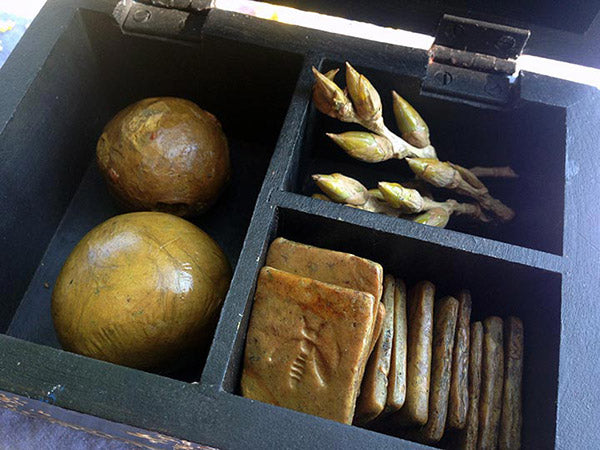
Here is my propolis collection and buds from the cottonwood trees which the bees collect the tree resin from.
The tree resin is not used in the hive in it's original form when collected by the bees. The bees process the tree resin in their mouths and then, almost magically the tree resin is concentrated into an array of least 180 different compounds which have been identified so far. There is a lot of research about the health benefits of propolis on the web. If you are observant, you can see the shiny propolis coming in on the legs of the bees in the spring.
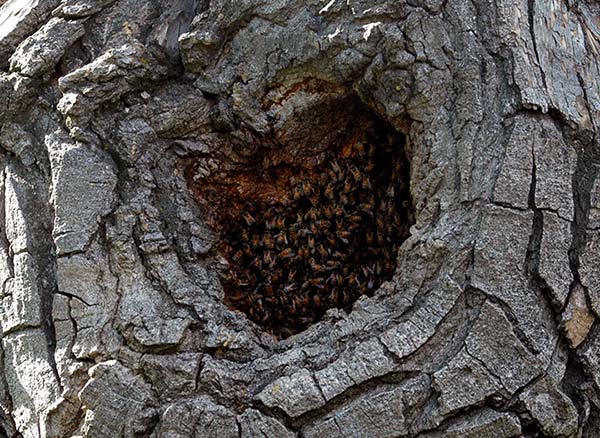
Bees in a hollow of a cottonwood tree. Bees use propolis to seal and protect their hive.
Behavioral Immunity: How do the bees use propolis?
I like to use the term “behavioral immunity” to describe bee behaviors that protect the colony and help the hives create a valuable immunity to dangerous pathogens in their environment. Another term “social immunity” describes how individual behaviors of each bee in the colony helps to inhibit the spread of disease and parasites. One of the most important of these behaviors is the bees' ability to collect and use propolis in the hive. A newly initiated large-scale field study by researcher Michael Simone-Finstrom at North Carolina State University and the Department of Biology at the University of Pennsylvania has found convincing evidence that propolis in the nest can influence honey bee immunity. The researchers noted. “It appears that honey bees have co-opted the defenses produced by plants as a type of “social immunity” or colony-level defense against pathogens.”
Imagine how vulnerable a colony of bees are when a hive is moist and warm, making it vulnerable to fungus, molds and bacteria. The hive also has sugars and proteins stored in cells, which is food for a myriad of creatures big and small. The potential of spreading pathogens around the colony is very high, with tens of thousands of bees living in very close quarters and field bees coming back into the hive after foraging. So the bees have developed a very important behavior of collecting propolis and coating every surface of the hive with it. The use of propolis by the bees can be seen as the new, pure, white combs gradually turn a yellowish tint.

Comb cell edges coated with propolis. Bees use propolis as a anti-bacterial and anti-microbial substance in their hive.
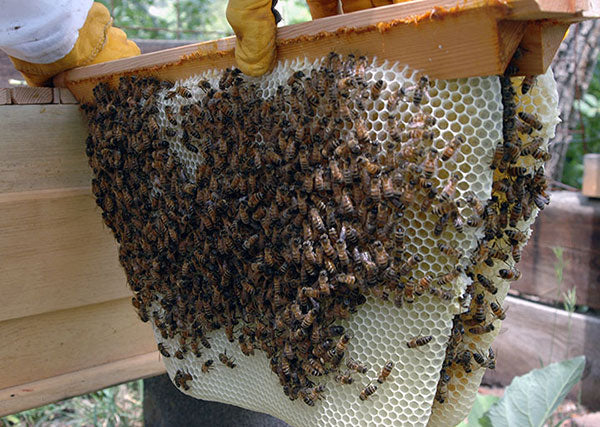
Newly drawn comb is "virgin" comb and is white until the bees coat it with propolis for additional comb strength and cleanliness.

Proplis outlines where the triangle shaped top bars where taken out of the hive.
The walls of the hive take on a yellow-orange color as propolis is used throughout. The propolis is anti-bacterial and anti-microbial, the bees use it against pathogenic microorganisms, but somehow it is not intended to kill everything in the hive. There exists a microbial forest in a healthy hive and each hive has a unique microbiology or fingerprint. Somehow these good microbes are beneficial to the health of the colony. They keep each other in check. If a chemical treatment is put into the hive, then this delicate balance is disrupted and bee diseases emerge. We need to let the bees manage these microbes, viruses, fungus's and parasites through the use of propolis, not the very recent use of chemical treatments.
Bees use propolis at hive entrance for ventilation
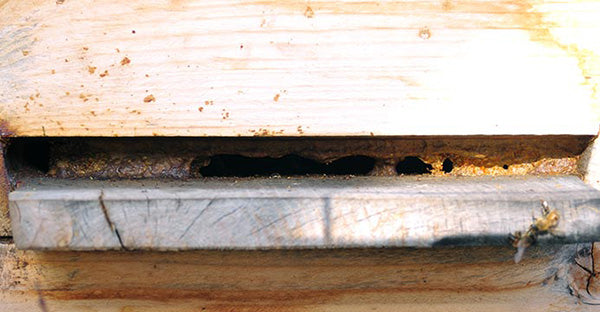
Bees use propolis at the entrance of their hive for ventilation, closing it down for winter and for defense against robber bees.
The bees also use the sticky propolis to regulate the opening of their entrance. Ventilation in a hive in all seasons is vitally important to the health of the colony. The question is, who is best to decide where and when to ventilate a hive, the beekeeper or the bees? The bees of course, and they are very skilled at this behavior. The bees have been using propolis to protect their hives for more then 125 million years and then along comes industrialization of bees and the situation gets “more tacky” and “less sticky”. The beekeepers found the sticky propolis too troublesome in the “new” hive designs and they decided to start breeding the propolis collecting behavior out of the bees. You can see where things will start going very wrong.
A short history of bee hives

Skep bee hives made from baskets and clay
Here a short history that should help to paint a picture. Before 1850 all hives had been log hives, box hives, skeps, and yes, top bar hives. The first sub-species of bees to North America were (Apis mellifera mellifera) the black bee, that originated in northern European climates.

Black bees from Finland where Corwin did some traveling to find out more about this different sub-species of honey bee.
These bees were perfect for most of North America with their amazing propolizing traits. These hives with the black colored mellifera mellifera, inhabiting them, used ample amounts of propolis to protect their hive. When the Langstroth hive, pronounced, Lang-strom : ) was invented, it touted having removable frames.

Langstroth Bee Hive - Stacked Boxes
It was pretty efficient, take out the frame, spin out the honey and put it back in. Because it is difficult to remove frames glued in with propolis, it made the Langstroth hives difficult to maintain. So the beekeepers at the time imported a different bee into the US that did not use as much propolis, because it was acclimated to the more milder climates of the Mediterranean. Then over the next 80 some years bee breeders continued selecting and breeding bees that did not have behaviors that produced copious amounts of propolis. We can see now that these newly bred bees have lost a vital aspect of their ancient genetics, they don't have the complex propolis behaviors that has protected them for millions of years.

Corwin visiting with Finland's top black bee guardian, Aimo Nurminen
So what do we do now that propolizing behavior has been bred out of the bees?
We need to sustain the bees with good propolizing behaviors, because propolis is key to a colonys' health. I have found that wild swarms from survivor genetics generally exhibit more complex propolizing behaviors. These bees are able to use propolizing behaviors to keep the hive free from invaders. These “feral” bees close up their entrance with propolis in the fall to ward off robbing bees and often even construct maze-like tunnels of propolis to foil robber bees. Because these feral bees still have the genetics for propolizing behaviors, they do not need intervention from the beekeeper. They close and seal the opening of the hive in a way that is best for their survival. In the spring they begin chewing wider and wider holes until the entrance is completely open. This is why we do not recommend using entrance reducers, but advocate something that the bees can push away. In the fall if your bees do not close up the entrance with propolis at all we recommend using only removable materials, like grass or sticks to closeup the entrance. We want to give the bees a chance to manage their own ventilation. If there is a series of hot days in the late fall or spring and the bees can't remove a wooden entrance reducer, then the bees will be in trouble and risk overheating.
How to collect and use propolis from a beehive

Rare propolis caves are created by bees with propolizing behavioral traits that are still intact.
Bees that still have complex propolizing behaviors will store high quality propolis in caves along the top bars and along the edges of the top of the hive. I find the higher grade propolis is more colorful, shiny and potent then the lower grade propolis found at the entrance, which is more tan and thick and seems to be mixed with other materials. For thousands of years humans have been using propolis for a variety of purposes. The ancient Greeks, Romans, and Egyptians were aware of the healing properties of propolis and made extensive use of it as a medicine.
As I move through the hive in the spring harvesting honey, I also collect the propolis on the edges of the bars and upper sides of the hive using the Hive Scraper Cleaning Tool.

Using the Hive Scraper Tool to scrape propolis from the top bars and collect onto wax paper.

Bee propolis being harvested from top bars with the Original Top Bar Hive Tool
I will form a little ball of propolis and keep adding to it as I go along. Collecting propolis becomes part of the harvest. A great way to quiet the bees while you are cleaning up the back of the hive or collecting propolis is to move the false back in front of where you are working and keep hoping it forward as you reveal more of the hive. Wax paper can be put in the bottom of the hive as you scrape, to catch and keep the propolis clean.

Bee propolis being harvested from the sides of a hive by placing wax paper on the bottom of the hive

The new design of the Hive Scraper and Clean Up Tool

The Hive Scraper Tool can also be used to scoop up propolis from the bottom of the hive. The stubby form of the Hive Scraper makes it ideal for maneuvering in hive.

Using the Hive Scraper Tool to scrape propolis from the top bars collecting it on wax paper
Each top bar should have a lot of propolis along the edges. If the propolis is too cold it will be brittle and will tend to pop off and crumble. Top bars that have had the honeycomb harvested off of them can be set in the sun for a few minutes, so that the propolis will become more pliable which makes for easier harvesting.
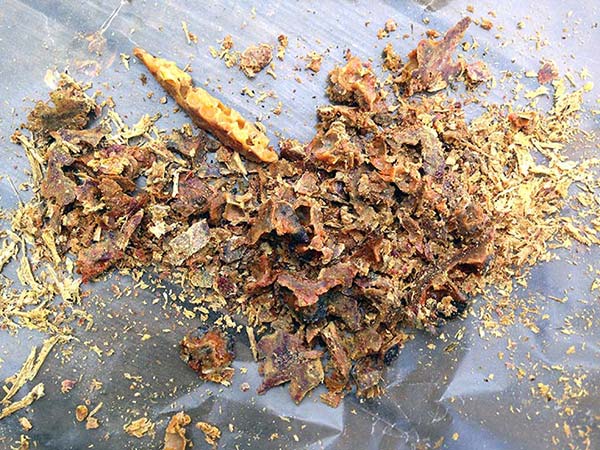
Propolis collected from the hive sitting on wax paper
When you have collected several ounces, separate any wax from the propolis.
Now a propolis tincture can be made using grain alcohol. The propolis is soaked in the alcohol for a couple of weeks, until the liquid becomes red and translucent. The wax will have settled to the bottom of the jar. I use a glass turkey baister to suck up the clear propolis tincture to fill tincture bottles. The propolis sludge and wax will be left behind in the jar and can be used as a wood lacquer or preservative.
Propolis has been praised for its antibacterial, antiseptic, anti-inflammatory, anti fungal, anesthetic, and healing properties. It is always best to test a small amount of the mixture in conjunction with careful physician monitoring before supplementing, especially if you have allergies.

My propolis collection formed into a patty for storage



































